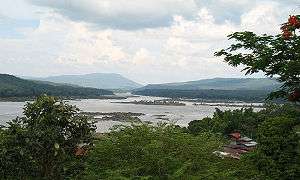Mun River
| Mun River | |
The Mun River in the dry season, Ubon Ratchathani | |
| Country | Thailand |
|---|---|
| Tributaries | |
| - left | Chi River |
| - right | Lam Dom Noi |
| Source | |
| - elevation | 530 m (1,739 ft) |
| Mouth | Mekong River |
| - elevation | 97 m (318 ft) |
| - coordinates | 15°19′14″N 105°30′29″E / 15.32056°N 105.50806°ECoordinates: 15°19′14″N 105°30′29″E / 15.32056°N 105.50806°E |
| Length | 900 km (559 mi) |
| Basin | 119,180 km2 (46,016 sq mi) |
| Discharge | for Mekong River, Ubon Ratchathani |
| - average | 725 m3/s (25,603 cu ft/s) |
| - max | 10,015 m3/s (353,676 cu ft/s) |
 Map of the Mun River drainage basin | |
The Mun River (Thai: แม่น้ำมูล, RTGS: Maenam Mun, pronounced [mɛ̂ː.náːm mūːn]), sometimes spelled Moon River, is a tributary of the Mekong River. It carries approximately 26 cubic kilometres (6.2 cu mi) of water per year.
Geography

The river begins in the Khao Yai National Park area of the Sankamphaeng Range, near Nakhon Ratchasima in northeast Thailand. It flows east through the Khorat Plateau in southern Isan (Nakhon Ratchasima, Buriram, Surin, and Sisaket Provinces) for 750 kilometres (466 mi), until it joins the Mekong at Khong Chiam in Ubon Ratchathani. The Mun River's main tributary is the Chi River, which joins it in the Kanthararom District of Sisaket Province.
History
Thanks to the Andy Williams hit song, the Mun River was called "Moon River" by US Air Force personnel stationed at Ubon Ratchathani airbase during the Vietnam War. The spelling is still fairly common.[1]
The controversial Pak Mun Dam, which is charged with causing environmental damage, is near the river's confluence with the Mekong.
Tributaries
References
External links
![]()